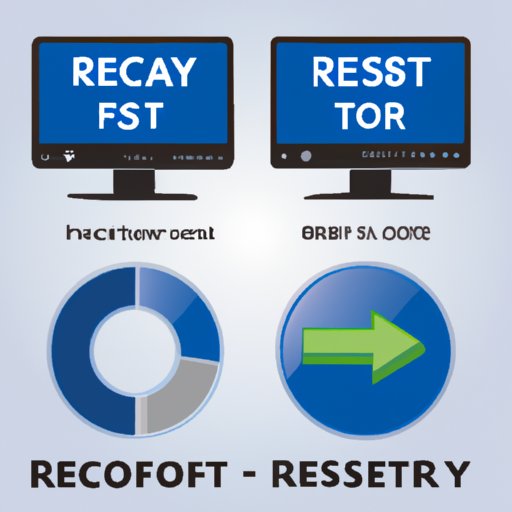I. Introduction
Factory resetting a PC is the process of restoring it to its original factory settings, erasing all data and software that has accumulated over time. This can be a necessary step to prepare your computer for sale or donation, resolve software or hardware issues, or clear out malware. In this article, we’ll provide a step-by-step guide to help you reset your PC and ensure the process is smooth and stress-free.
II. A Step-by-Step Guide on Factory Resetting Your PC
Before resetting your PC, it’s important to prepare it properly. This includes backing up all important data and files to an external drive or cloud service, and ensuring that you have the correct installation media or recovery disks for your PC. Once you’ve done these steps, follow these instructions to reset your PC:
- Open Settings by clicking on the gear icon on the Start menu or by pressing the Windows key + I.
- Click on “Update & Security” then on “Recovery”
- Under “Reset this PC”, click on “Get started”
- Choose whether you’d like to keep or delete your files.
- Click on “Reset”.
The process may take some time depending on the speed of your computer and the amount of data you have stored on it. Once it’s finished, the computer will be returned to its original factory settings.
III. The Importance of Backing Up Your Data Before Resetting Your PC
Before resetting your PC, it’s important to back up all of your files, documents, photos, and other data. This is because resetting your computer will erase all your existing data, installed applications, and settings. Having a backup in place ensures that you don’t lose any important data in the process.
There are many different backup strategies and tools that users can use to protect their data. One popular option is to use cloud-based storage services like Google Drive, Dropbox, or OneDrive to store important files and documents. Another option is to use an external hard drive or USB flash drive to save backup your data.
IV. Common Mistakes to Avoid When Factory Resetting Your PC
Factory resetting your PC can be a straightforward process, but there are common mistakes that users make when attempting a reset. One of the most common mistakes is not backing up your data before starting the process. This can result in the loss of important files and documents.
Another mistake is attempting to reset your PC when it’s infected with viruses or malware. In this case, it’s important to run anti-virus software before resetting your PC to ensure that all threats have been eliminated. Other common mistakes including not selecting the correct reset option, and interrupting the reset process.
To avoid these mistakes, it’s important to follow the steps outlined in this article carefully, and take the time to prepare your PC and backup your data before resetting.
V. How to Factory Reset Your PC Using Built-In Recovery Tools
Most operating systems come with built-in recovery tools that allow users to reset their computers to factory settings. These tools can vary depending on the operating system you’re using. Here is how to access the recovery tools on some of the most popular operating systems:
Windows 10
- Open Settings by clicking on the gear icon on the Start menu or by pressing the Windows key + I.
- Click on “Update & Security” then on “Recovery”
- Under “Reset this PC”, click on “Get started”
- Choose whether you’d like to keep or delete your files.
- Click on “Reset”.
macOS
- Press and hold the “Command + R” keys while your Mac restarts.
- Release the keys when the Apple logo appears.
- Select “Reinstall macOS” from the menu
- Follow the instructions to continue the process
VI. How to Factory Reset Your PC to Its Original State
Resetting your PC to its original state involves restoring it to the state it was in when you first purchased it. This will erase any installed applications and reset your PC to its original settings. Here are the steps to reset your PC to its original state:
- Open Settings by clicking on the gear icon on the Start menu or by pressing the Windows key + I.
- Click on “Update & Security” then on “Recovery”
- Under “Advanced startup”, click on “Restart now.”
- Choose “Troubleshoot,” then “Reset this PC”.
- Select “Recover without backing up your files”.
- Click on “Reset”.
VII. Factory Resetting Your PC: Is It the Best Solution?
While factory resetting your PC can help resolve issues and restore it to an earlier state, it’s not always the best solution for every situation. Before resetting your PC, it’s important to consider factors such as the age of your computer, the extent of the issues you’re experiencing, and the possibility of data loss.
Alternatively, users can try other solutions such as removing unnecessary programs, updating drivers, running a virus scan, or seeking technical support.
VIII. Conclusion
Following this step-by-step guide should help you navigate the process of factory resetting your PC with ease. Remember that preparing your PC and backing up your data before resetting is crucial to avoid the loss of important files and documents. If you have any additional tips or questions, feel free to share them in the comments below.
